

We focus on the opioid and ghrelin receptors and develop novel ligands selective for their receptors.
Opioid receptors are classified into three types: μ opioid receptor (MOR), δ opioid receptor (DOR), and κ opioid receptor (KOR).
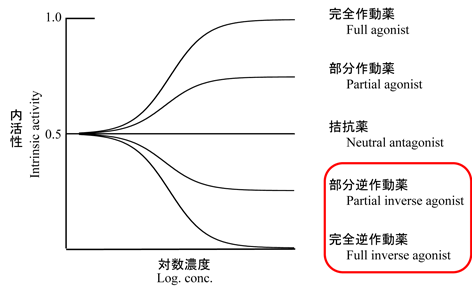
We found DOR inverse agonists during the structure-activity relationship study of DOR antagonist naltrindole (NTI)1). In general, agonist shows positive activities, whereas inverse agonist exerts negative activities. Although there is a massive amount of research about agonists and antgonists, the reports about inverse agonists are fewer. Therefore, the detailed physiological roles of inverse agonists remain unclear. We attempt to develop more potent DOR inverse agonists and investigate the physiological roles of DOR inverse agonists2), 3).
1) Bioorg. Med. Chem. Lett., 2015, 25, 2927-2930.
2) ACS Chem. Neurosci., 2019, 10, 2237-2242.
3) ACS Chem. Neurosci., 2019, 10, 3939-3945.
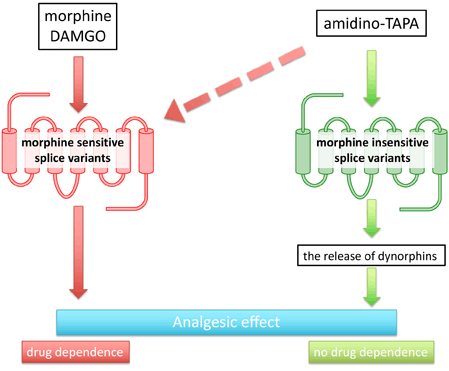
It is known that MOR, which is a main target receptor of clinically used opioid analgesics, has some dozens of splice variants (SV), which consist of different amino acid sequences. MOR SVs are categorized into two types: morphine sensitive (red-colored receptor in the above figure) and morphine insensitive (green-colored receptor in the above figure). As the activation of the morphine insensitive MOR SVs induces the release of endogenous opioid peptides dynorphins with KOR agonistic activities to exhibit analgesic effects, drug dependence is expected to be hardly developed. Therefore, selective agonists for the morphine insensitive MOR SVs are promising analgesics with fewer side effects. Indeed, peptidic compound amidino-TAPA, which interacts with both types of MOR SVs, reportedly shows antinociceptive effects and does not induce the drug dependence under the conditions without pain. We now attempt to develop the nonpeptidic selective agonists for the morphine insensitive MOR SVs.
1) Neuropharmacology, 2014, 76, 198-203.
2) a) Eur. J. Pharmacol., 2007, 560, 150-159., b) Eur. J. Pharmacol., 2011, 651, 66-72., c) Eur. J. Pharmacol., 2013, 711, 80-86.
3) Psychopharmacology, 2010, 212, 215-225.
4) Pain clinic, 2017, 38, S196
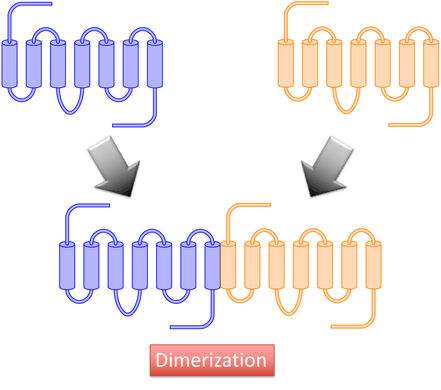
It is reported that G-protein coupled receptors (GPCRs) can form homomeric or heteromeric dimers1). GPCR dimers are known to form not only in vitro but also within an organism such as rodent2) and human3). Moreover, GPCR dimers are reported to physiologically function in vivo, and be paid attention as a promising targets for drug development.
We focus on the MOR-DOR heterodimer and attempt to develop selective agonists for the MOR-DOR heterodimer.
1) Pharmacol. Rev., 2005, 57, 289-298.
2) (a) Sci. Signal., 2010, 3, ra54., (b) Br. J. Pharmacol., 2015, 172, 2507-2518.
3) Nature Med., 2001, 7, 1003-1009.
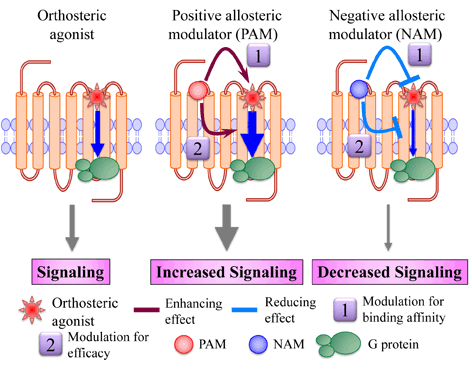
Receptors have two kinds of binding sites: orthosteric and allosteric binding sites. The former is the site to which endogenous peptides can bind, whereas the latter is the other binding sites. Positive allosteric modulator (PAM) and negative positive modulator (NAM) can enhance and reduce the effects induced by orthosteric agonists, respectively. As it is generally believed that allosteric modulators are of advantage to attain the receptor selectivity compared with orthosteric ligands, allosteric modulators are paid attention as promising drug candidates with fewer side effects1).
We are now seeking allosteric modulators for opioid receptors2).
1) Br. J. Pharmacol., 2015, 172, 277-286.
2) J. Pharmacol. Sci., 2018, 137, 67-75.
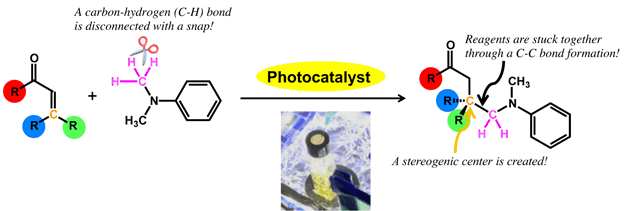
Organic photochemical reactions would enable the construction of complex molecules in shorter steps, which is difficult to be obtained by conventional thermal reactions. Moreover, organic photochemical reactions can provide green synthetic methodologies because in many cases they require fewer reagents compared with the thermal reactions. Therefore, organic photochemical reactions are suitable for process chemistry.
We develop novel photochemical reactions such as investigations of chiral photocatalysts which enable enantioselective conjugate additions of activated intermediates photochemically induced from tertiary amines with enones.
Org. Biomol. Chem., 2015, 13, 8919-8924.
Heterocycles, 2018, 97, 591-603.
RSC Adv., 2020, 4, 388-392.
ChemPhotoChem, 2020, 4, 388-392.
Chem. Eur. J., 2021, 27, 5171-5179.